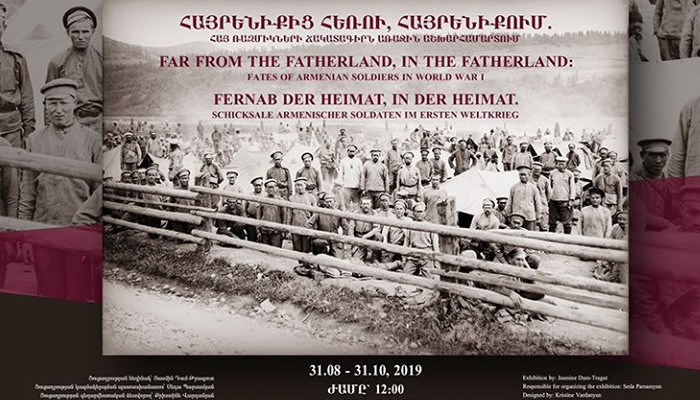Far from the fatherland, in the fatherland: Fates of Armenian Soldiers in World War I
 2012 Monday, 26 August, 2019, 23:15 On 31 August, at the temporary exhibition hall of Armenian Genocide Museum-Institute Foundation a new exhibition and the presentation of the catalogue “Far from the Fatherland, in the Fatherland: Fates of Armenian Soldiers in World War I” will take place. Armenian Genocide Museum-Institute Foundation presents the research project of Assoc. Prof. Dr. Jasmine Dum-Tragut, Head of the Department of Armenian Studies at the Centre for the Study of the Christian East at the University of Salzburg, throughout a temporary exhibition and a catalogue dedicated to the describe the lives of Armenian soldiers in World War I. The experience of eastern Armenian soldiers fighting in the Russian army will be presented, their experiences far from home, on the front, when captured, their everyday experiences in enemy hands – in Austro-Hungarian captivity – their escape or liberation, their return to the fatherland and subsequent lives. The exhibition is equipped with unique archival photos, videos and exhibits, through which and through accompanying explanatory texts, an attempt is made to reveal the unusual life of the soldiers. 100 years old soldiers’ song and poems forms an important part of the exhibition. The voice record of Arshak Manukyan; a war prisoners is especially touching, which tells the following: Armenian born in Lcen, lived in Yekaterinoslav, 30 years old, by profession confectioner, recites and sings the Armenian folk “The Armenian Crane”, Arshak labeled this song as “The bird of an unfortunate POW” 15.08.1915. Being a prisoner of war, overcome the insurmountable, violence, starvation, illness, stress, death or home return, trying to integrate into society, whose attitude was unequivocal: many of the prisoners of war would still have to bear the label of a betrayer. The exhibition is a unique platform to screen one of the heaviest consequences of any war. POW camps have been erected for about 1 million soldiers and 10,000 officers in Austria-Hungary. Of a total of 50 camps and stations, far less than the half were located in the territory of present-day Austria. In preparation for this exhibit, as much information as possible was collected from archives in Austria, Armenia and Russia, countless villages in Armenia were visited in search of traces of these prisoners of war, and the stories of the village elders, of relatives who were found, and even of the children of these Armenian prisoners were written down. Their narratives and memories, pictures from family albums, along with the historical documents from various archives, allow us to compose the life stories of these Armenian prisoners of war. Many families knew about their relatives’ time in captivity but for some this was completely new. The opening ceremony will be in presence of descendants of war prisoners, guests, state officials, diplomats, academics, journalists and other guests from Armenia and Austria as well.
|

Staff strike forces Louvre to close doors to visitors
101615.12.2025, 23:56
‘Pluribus’ is the most watched show in Apple TV history!
148814.12.2025, 22:36
Johnny Depp Sets First English-Language Adaptation of Mikhail Bulgakov’s Classic ‘The Master and Margarita’
232811.12.2025, 00:46
Golden Globes 2026: The full list of nominees
220709.12.2025, 00:32
Brazil police ID suspect in Matisse theft
210708.12.2025, 23:48
Warner Bros fight heats up with $108 billion hostile bid from Paramount
215208.12.2025, 22:59
Leonardo DiCaprio Is TIME’s 2025 Entertainer of the Year
160308.12.2025, 22:18
Water leak at Paris Louvre Museum damages books at Egyptian antiquities department
131908.12.2025, 12:12
